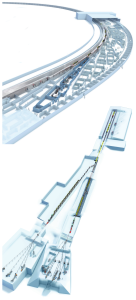What is a synchrotron?
In brief a synchrotron is a large facility using accelerated beams of charged particles (electrons) in order to generate a high intensity, tunable, polarised source of x-ray radiation. The x-ray radiation available from this source can be used for a huge variety of physical, chemical, biological, structural and engineering investigations of atoms, molecules, surfaces, crystals, new materials, assemblies of materials, proteins, new pharmaceuticals as well as complex interactions of all of these. The use of x-rays allow for picking out the response of materials on for instance: small length scales, high energy scales, or at particular energies that are specific to differing elements within the material that is to be studied. As a result of the differing needs of differing investigations synchrotron radiation facilities are typically built with between 10-50 different “beamlines” which simultaneously deliver x-rays at differing energies to sets of state-of-the-art equipment built for these differing purposes outlined above.
For an overview of the synchrotron light sources of the world visit lightsources.org to see the locations of more than 45 synchrotron radiation sources worldwide, of which 15 are in Europe. Of the 45 worldwide Irish research groups currently use about 12 of these sources.
Diamond Light Source: “We are all scientists”
ALBA Synchrotron Light source: “What is a synchrotron light source”
Diamond Light Source: “Synchrotron Technology”
Leave a Reply
You must be logged in to post a comment.

